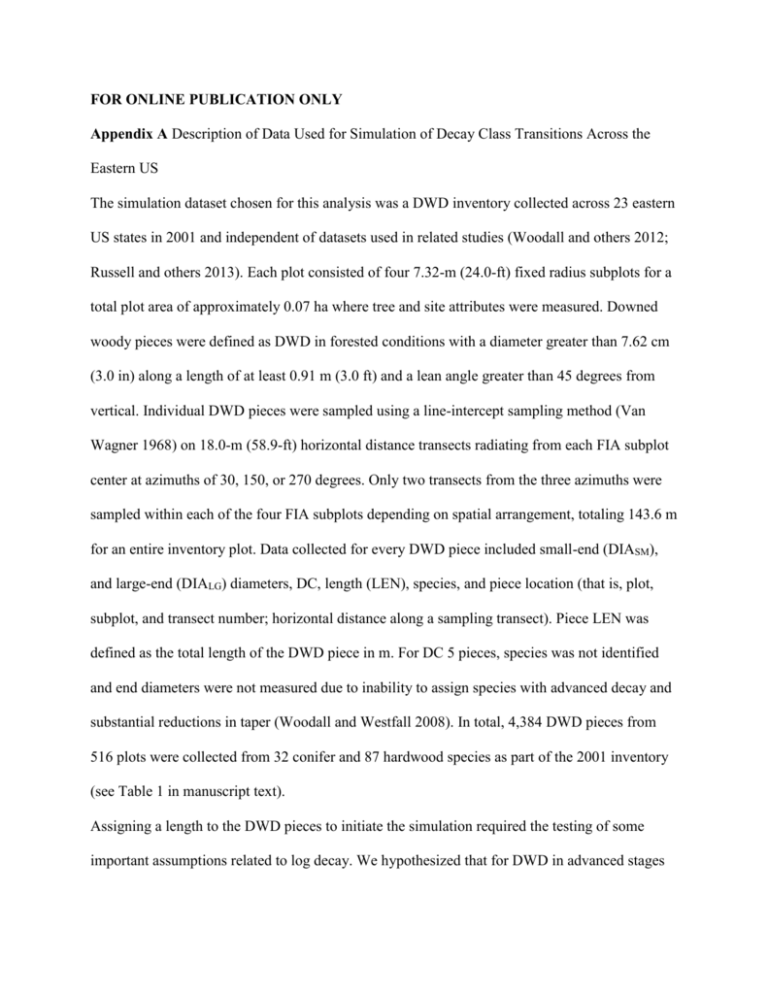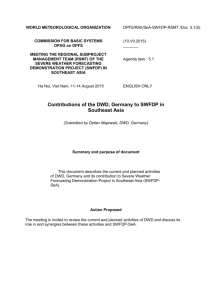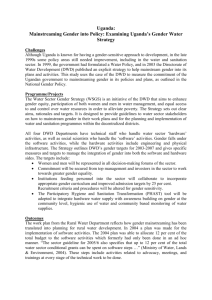FOR ONLINE PUBLICATION ONLY Appendix A Description of Data
advertisement

FOR ONLINE PUBLICATION ONLY Appendix A Description of Data Used for Simulation of Decay Class Transitions Across the Eastern US The simulation dataset chosen for this analysis was a DWD inventory collected across 23 eastern US states in 2001 and independent of datasets used in related studies (Woodall and others 2012; Russell and others 2013). Each plot consisted of four 7.32-m (24.0-ft) fixed radius subplots for a total plot area of approximately 0.07 ha where tree and site attributes were measured. Downed woody pieces were defined as DWD in forested conditions with a diameter greater than 7.62 cm (3.0 in) along a length of at least 0.91 m (3.0 ft) and a lean angle greater than 45 degrees from vertical. Individual DWD pieces were sampled using a line-intercept sampling method (Van Wagner 1968) on 18.0-m (58.9-ft) horizontal distance transects radiating from each FIA subplot center at azimuths of 30, 150, or 270 degrees. Only two transects from the three azimuths were sampled within each of the four FIA subplots depending on spatial arrangement, totaling 143.6 m for an entire inventory plot. Data collected for every DWD piece included small-end (DIASM), and large-end (DIALG) diameters, DC, length (LEN), species, and piece location (that is, plot, subplot, and transect number; horizontal distance along a sampling transect). Piece LEN was defined as the total length of the DWD piece in m. For DC 5 pieces, species was not identified and end diameters were not measured due to inability to assign species with advanced decay and substantial reductions in taper (Woodall and Westfall 2008). In total, 4,384 DWD pieces from 516 plots were collected from 32 conifer and 87 hardwood species as part of the 2001 inventory (see Table 1 in manuscript text). Assigning a length to the DWD pieces to initiate the simulation required the testing of some important assumptions related to log decay. We hypothesized that for DWD in advanced stages of decay (for example, DC 3, 4, and 5) length may have shortened through breakage or fragmentation. Hence, we tested for differences in observed length (that is, the 2001 measurement) and predicted length assuming a DC 1. Length was predicted using equations that employed observed DC (1 through 5), DIASM and DIALG as independent variables (Woodall and others 2008). For the purposes of simulating DC dynamics of the DWD population measured in 2001, we considered all DWD pieces to be non-decayed. This included setting their length equal to their 2001 measurement and assuming no structural loss due to decay. We refit models predicting length using a multiple linear regression with DC, DIASM, and DIALG as independent variables (Woodall and others 2008; their Eq. 3) using DWD data measured at recent FIA inventories in 2002-2010 (Woodall and others 2012) using multiple linear regression. Predictions of length for conifer (residual SE = 4.03 m; R2 = 0.33) and hardwood species (residual SE = 3.86 m; R2 = 0.37) were tested against observed length using a two-one-sided test (Wellek 2003) in an equivalence testing framework (Robinson and Froese 2004). Results indicated no dissimilarity between observed and predicted length, indicating that setting length equal to the observed length measured in 2001 was appropriate to initiate the simulation. The DD5 variable, MAT, and additional climate information were obtained by specifying latitude, longitude, and elevation of each FIA plot location to a spline surface model developed from climate station data across forests of North America (Rehfeldt 2006; USFS 2012). References Rehfeldt, G.E., 2006. A spline model of climate for the western United States. USDA For. Serv. Gen. Tech. Rep. RMRS-165. Robinson, A.P., Froese, R.E., 2004. Model validation using equivalence tests. Ecological Modelling 176, 349-358. Russell, M.B., Woodall, C.W., Fraver, S., D'Amato, A.W., 2013. Estimates of coarse woody debris decay class transitions for forests across the eastern United States. Ecological Modelling 251, 22-31. United States Forest Service, 2012. Research on forest climate change: potential effects of global warming on forests and plant climate relationships in western North America and Mexico. Rocky Mountain Research Station, Moscow Laboratory. http://forest.moscowfsl.wsu.edu/climate/ (last accessed 28 June 2012). Van Wagner, C.E., 1968. The line-intersect method in forest fuel sampling. Forest Science 14, 20-26. Wellek, S., 2003. Testing statistical hypotheses of equivalence. Chapman and Hall, London. Woodall, C.W., Walters, B.F., Westfall, J.A., 2012. Tracking downed dead wood in forests over time: development of a piece matching algorithm for line intercept sampling. Forest Ecology and Management 277, 196-204. Woodall, C.W., Westfall, J.A., 2008. Controlling coarse woody debris inventory quality: taper and relative size methods. Canadian Journal of Forest Research 38, 631-636. Woodall, C.W., Westfall, J.A., Lutes, D.C., Oswalt, S.N., 2008. End-point diameter and total length coarse woody debris models for the United States. Forest Ecology and Management 255, 3700-3706. Appendix C Decay rate constants k predicting the annual decomposition of conifers and hardwoods located in four contrasting climate regimes, grouped by their mean annual temperature (MAT; °C). Curves displayed assume a 100-kg downed woody debris piece after using a decay class and volume reduction factor approach. Appendix D Decay rate constants k predicting the annual decomposition for selected species using a decay class and volume reduction factor approach. Species displayed are for the minimum, mode, and maximum k values observed for conifers (black) and hardwoods (gray) assuming a 100-kg downed woody debris piece.










